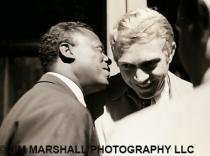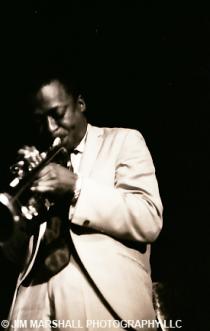In honor of Black History month, we thought we’d focus February’s blogs on another of Jim’s musical heroes: jazz musician, trumpeter, bandleader, and composer extraordinaire Miles Davis, widely considered one of the most influential musicians of the 20th century.
When I first met Jim, I knew almost nothing about jazz; I was deplorably ignorant, really. So Jim, as always, went about murdering that ignorance in the most effective of ways by showing me the images and than playing music of his favorites.
I especially remember when he introduced me to Miles Davis’ recordings from 1959 and 1960, “Kind of Blue” and “Sketches of Spain.” I remember one of Jim's favorite things was to slip a tape into his bedroom system, crack open a nice bottle of white and just lay back and listen while the soft SF afternoon light streamed through the windows. It was the true personification of cool and hot all at the same time. Perfect.
Hearing Miles for the first time for me was like someone blew the cobwebs out of my ears … and less than a decade later I was a music journalist in NYC interviewing Dizzy Gillespie and the like for “Windplayer Magazine.” Just another aspect of my career for which I owe more than I can say to the ole man.
From the Miles Davis Wikipedia page: “Producer Quincy Jones, one of Davis’ longtime friends, wrote: “(Kind of Blue) will always be my music, man. I play Kind of Blue every day — it’s my orange juice. It still sounds like it was made yesterday.” Pianist Chick Corea, one of Miles’ acolytes, was also struck by its majesty, later stating, “It’s one thing to just play a tune, or play a program of music, but it’s another thing to practically create a new language of music, which is what Kind of Blue did.
“One significant aspect of Kind of Blue is that the entire record, not just one track, was revolutionary. Gary Burton noted this occurrence, stating: “It wasn’t just one tune that was a breakthrough, it was the whole record.”
And, if you were hanging out with Jim and Miles Davis came up … he was likely to share the following memories, at least he did with me. Jim admitted that he was in awe of Miles, I think with me he used the phrase star struck. And Miles, a notoriously cantankerous individual, was far less approachable than the mellow, diffident John Coltrane, who took an instant liking to Jim. You can see it in the way Jim’s work with Miles progresses, starting with live shots and quick grabs backstage, Miles seemingly oblivious to Jim’s presence.
This is how I remember hearing one of Jim’s favorite Miles stories, told ruefully even decades after it happened: He was walking by Miles backstage probably in San Francisco or Monterey in the early '60s, they had a nodding acquaintance at the time. And Jim gets the bright idea to make conversation in an attempt to get to know Miles better. I paraphrase: “Hey, Miles, why do you play a green trumpet?” to which the take-no-prisoners Miles retorts, “Mothafucka, why are you askin’ me about the color of my trumpet? I don’t ask you why you are using a black camera!” I remember the way Jim flinched when he first told me that story, like Miles had just told him off the night before even though it was two decades ago; he looked a bit like a dog that got kicked. And that’s the way it could have ended, but thankfully for all of us, Jim just had to give connecting with Miles one more try, this time leading with his one true strength, his work.
At another event, maybe the Monterey Jazz Festival in 1963, Miles is hanging out off stage surrounded by friends, bandmates, handlers and the like. After the earlier altercation, Jim is petrified to go up to Miles. Instead, he has brought along one of his favorite portraits, a print of John Coltrane taken when he was at Ralph Gleason’s house in Berkeley. Jim tells the guy that when he gets a moment could he please give the Coltrane print to Miles with Jim's highest regards and then stands back to wait. When Miles sees the print he flips out, goes over to Jim to thank him, tells him that Coltrane is one of his favorite musicians (Jim's says "Yeah, I know.") Miles looks Jim dead in the eye with those crazy laser beams as only Miles could and asks, “Why don’t you ever take pictures like that of me?” To which Jim replies, “Why don’t you let me?”
Next blog: The fruits of Jim’s labor when Miles Davis finally “lets him.” Stay tuned.
- Jim Marshall Photography LLC Newsroom blog
- Log in to post comments


